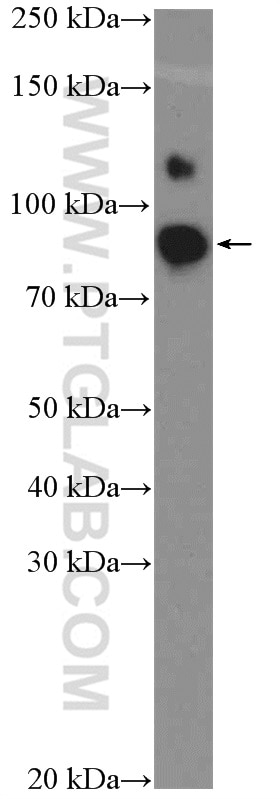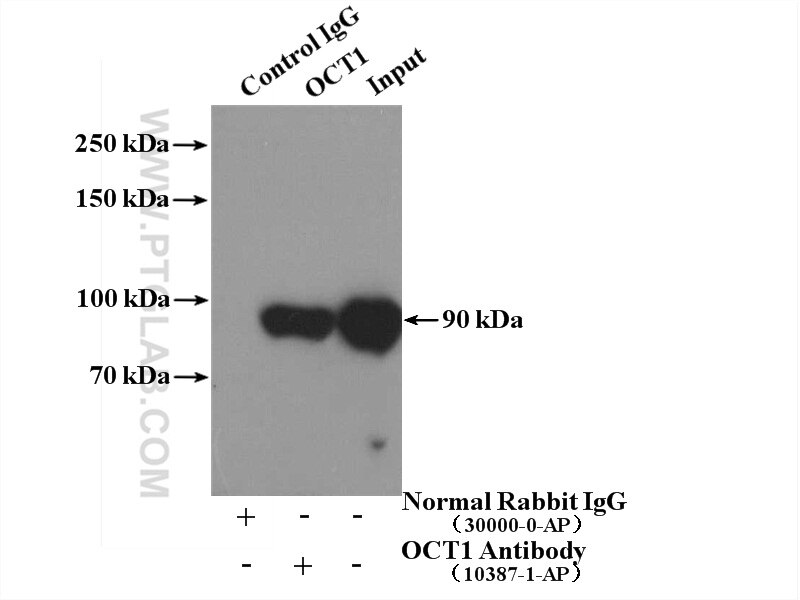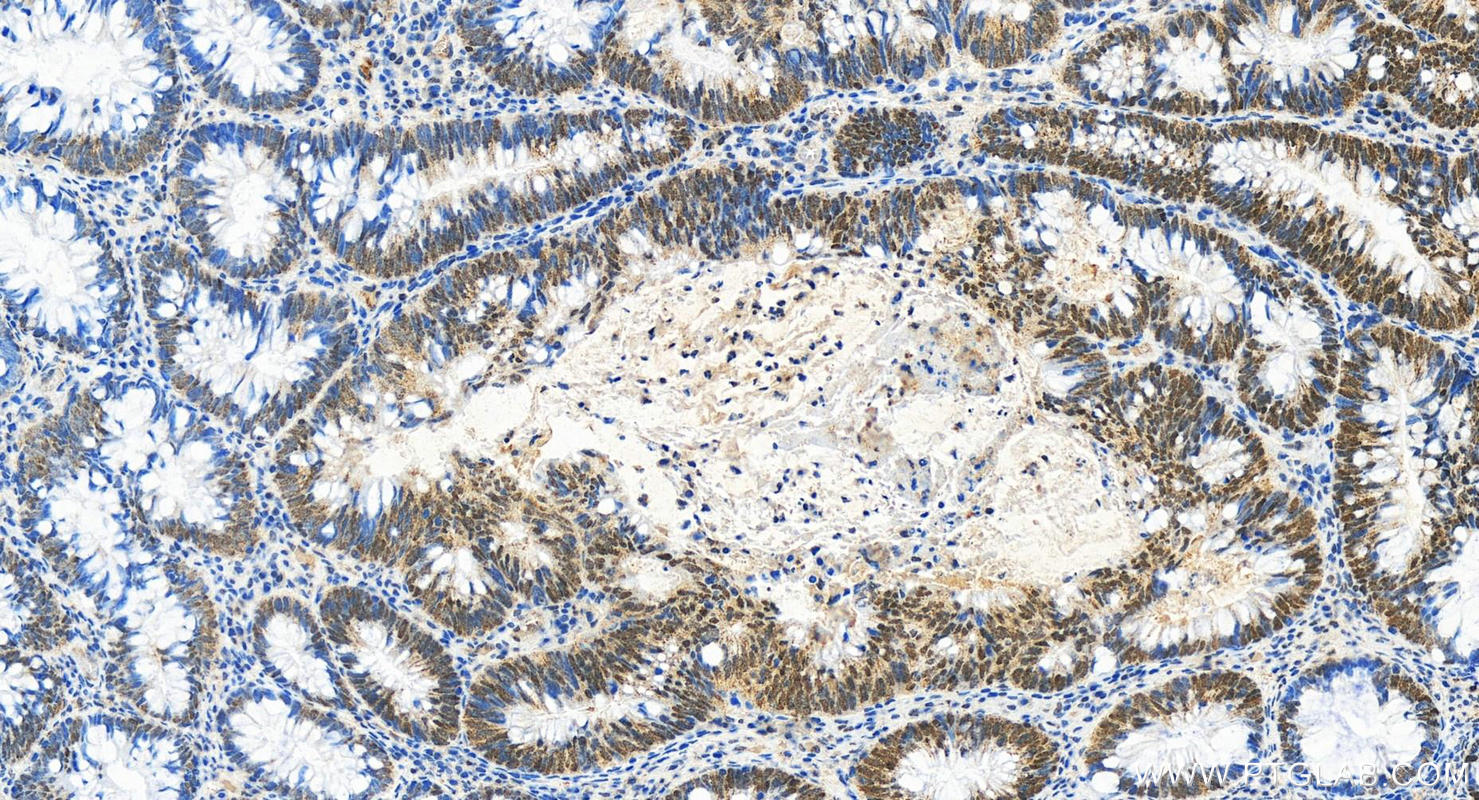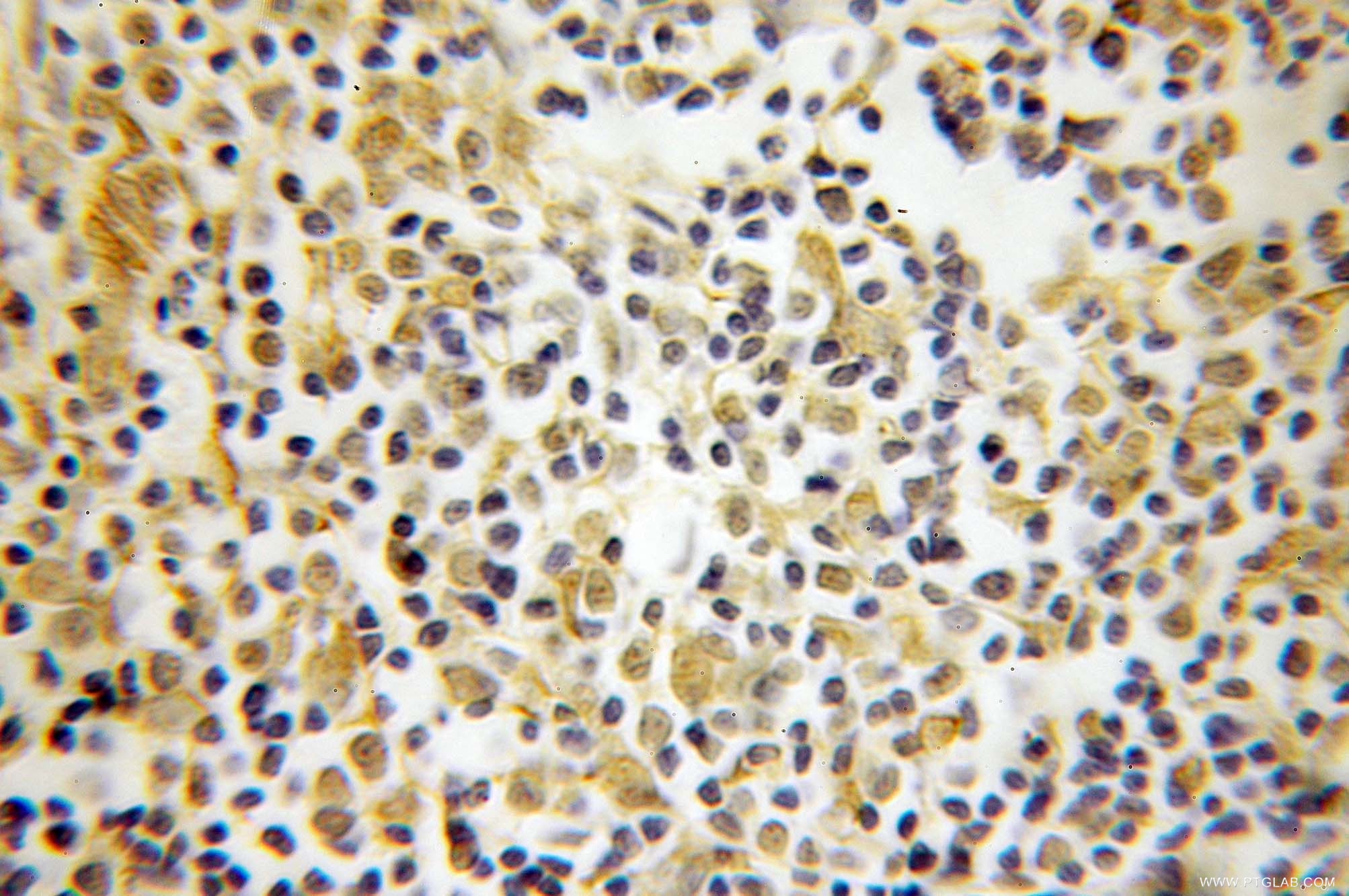- Phare
- Validé par KD/KO
Anticorps Polyclonal de lapin anti-OCT1
OCT1 Polyclonal Antibody for WB, IHC, IF/ICC, IP, ELISA
Hôte / Isotype
Lapin / IgG
Réactivité testée
Humain et plus (3)
Applications
WB, IHC, IF/ICC, IP, ChIP, ELISA
Conjugaison
Non conjugué
N° de cat : 10387-1-AP
Synonymes
Galerie de données de validation
Applications testées
| Résultats positifs en WB | cellules HEK-293, cellules HeLa, cellules HepG2, cellules NCCIT |
| Résultats positifs en IP | cellules HeLa |
| Résultats positifs en IHC | tissu de cancer du côlon humain, tissu de lymphome humain il est suggéré de démasquer l'antigène avec un tampon de TE buffer pH 9.0; (*) À défaut, 'le démasquage de l'antigène peut être 'effectué avec un tampon citrate pH 6,0. |
| Résultats positifs en IF/ICC | cellules HeLa, |
Dilution recommandée
| Application | Dilution |
|---|---|
| Western Blot (WB) | WB : 1:2000-1:12000 |
| Immunoprécipitation (IP) | IP : 0.5-4.0 ug for 1.0-3.0 mg of total protein lysate |
| Immunohistochimie (IHC) | IHC : 1:1000-1:4000 |
| Immunofluorescence (IF)/ICC | IF/ICC : 1:500-1:2000 |
| It is recommended that this reagent should be titrated in each testing system to obtain optimal results. | |
| Sample-dependent, check data in validation data gallery | |
Applications publiées
| KD/KO | See 1 publications below |
| WB | See 13 publications below |
| IHC | See 1 publications below |
| IF | See 1 publications below |
| ChIP | See 2 publications below |
Informations sur le produit
10387-1-AP cible OCT1 dans les applications de WB, IHC, IF/ICC, IP, ChIP, ELISA et montre une réactivité avec des échantillons Humain
| Réactivité | Humain |
| Réactivité citée | rat, Humain, porc, souris |
| Hôte / Isotype | Lapin / IgG |
| Clonalité | Polyclonal |
| Type | Anticorps |
| Immunogène | OCT1 Protéine recombinante Ag0586 |
| Nom complet | POU class 2 homeobox 1 |
| Masse moléculaire calculée | 76 kDa |
| Poids moléculaire observé | 90 kDa |
| Numéro d’acquisition GenBank | BC003571 |
| Symbole du gène | POU2F1 |
| Identification du gène (NCBI) | 5451 |
| Conjugaison | Non conjugué |
| Forme | Liquide |
| Méthode de purification | Purification par affinité contre l'antigène |
| Tampon de stockage | PBS with 0.02% sodium azide and 50% glycerol |
| Conditions de stockage | Stocker à -20°C. Stable pendant un an après l'expédition. L'aliquotage n'est pas nécessaire pour le stockage à -20oC Les 20ul contiennent 0,1% de BSA. |
Informations générales
The POU class 2 homeobox 1 (POU2F1), also known as octamer-binding transcription factor-1 (OCT-1), is a ubiquitous nuclear protein that regulates the transcription of target genes by binding to a cis-acting octamer element(5'-ATTTGCAT-3'). It participated in the regulation of housekeeping genes, including histone H2B and snRNAs, for cell differentiation and proliferation [PMID:3462701]. In addition, it functions as a cellular stress sensor that modulates activities of tissue-specific target genes involved in immune and inflammatory responses [PMID:16322220]. It also acts as a repressor for the cytokine-inducible, NF-kB-dependent expression of E-selectin and the vascular cell adhesion molecule during vascular inflammation. Otherwise, it can interact with nuclear hormone receptors, such as the retinoid X receptor, the thyroid hormone receptor and the glucocorticoid receptor, and influence their transcription activity[PMID:17192276].
Protocole
| Product Specific Protocols | |
|---|---|
| WB protocol for OCT1 antibody 10387-1-AP | Download protocol |
| IHC protocol for OCT1 antibody 10387-1-AP | Download protocol |
| IF protocol for OCT1 antibody 10387-1-AP | Download protocol |
| IP protocol for OCT1 antibody 10387-1-AP | Download protocol |
| Standard Protocols | |
|---|---|
| Click here to view our Standard Protocols |
Publications
| Species | Application | Title |
|---|---|---|
Mol Biol Evol Long-term artificial selection reveals a role of TCTP in autophagy in mammalian cells. | ||
Food Funct Anti-hyperuricemic potential of stevia (Stevia rebaudiana Bertoni) residue extract in hyperuricemic mice | ||
Food Funct Ferulic acid supplementation alleviates hyperuricemia in high-fructose/fat diet-fed rats via promoting uric acid excretion and mediating the gut microbiota | ||
Cell Oncol (Dordr) The POU2F1/miR-4490/USP22 axis regulates cell proliferation and metastasis in gastric cancer. | ||
iScience MASTL is enriched in cancerous and pluripotent stem cells and influences OCT1/OCT4 levels.
| ||
Mol Cell Endocrinol MiR-451a attenuates free fatty acids-mediated hepatocyte steatosis by targeting the thyroid hormone responsive spot 14 gene. |







